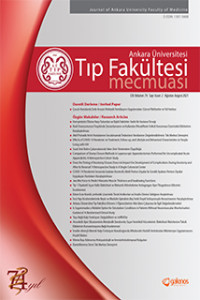Is Sugammadex a Reliable Option for Extubation Conditions in Patients Without Neuromuscular Monitorisation Guidance? A Randomised Clinical Study
Abstract
Objectives: In patients undergoing septorhinoplasty, anesthesia and management of postoperative care may be challenging, especially at extubation,
due to nasal packing. Maintaining a patent airway is a critical issue in these patients. In this study, extubation characteristics of sugammadex in the
absence of neuromuscular monitorization were evaluated.
Materials and Methods: In this randomized, prospective trial, 90 patients who underwent septorhinoplasty were allocated to groups to reversal
with either neostigmine or sugammadex, with or without neuromuscular monitorization guidance for extubation. The induction and maintenance
were standardized for all groups and groups were differed according to the reversal agent and presence of neuromuscular monitorization. The
extubation conditions were recorded. Extubation time and time spent in postanesthesia care unit were also recorded.Adverse events such as throat
pain, cough, straining, or laryngospasm were recorded in the operating room and until discharge from the post anesthesia care unit. Nasal bleeding
and change of packing were recorded.
Results: The mean extubation time (time from the administration of reversal agent to extubation) and post anesthesia care unit stay time [Group
1: 20.5±4.1 minute (min), Group 2: 21.3±7.3 min, Group 3: 12 12.2±2.9 min, Group 4: 12.7±2.5 min] (p=0.001) were significantly shorter in the
sugammadex groups than in the neostigmine groups. Number of patients in the sugammadex groups required less mask ventilation compared to
the neostigmine groups, regardless of the neuromuscular monitorization.
Conclusion: Sugammadex may provide favorable extubation conditions than neostigmine regardless of objective neuromuscular monitorization
Keywords
Ethical Statement
This study was approved by the Ankara University’s Institutional Ethical Board
Supporting Institution
-
Project Number
-
Thanks
-
References
- 1. Geldner G, Niskanen M, Laurila P, et al. A randomised controlled trial comparing sugammadex and neostigmine at different depths of neuromuscular blockade in patients undergoing laparoscopic surgery. Anaesthesia. 2012;67:991-998.
- 2. Jones RK, Caldwell JE, Brull SJ, et al. Reversal of profound rocuroniuminduced blockade with sugammadex: a randomized comparison with neostigmine. Anesthesiology. 2008;109:816-824.
- 3. Blobner M, Eriksson LI, Scholz J, et al. Reversal of rocuronium-induced neuromuscular blockade with sugammadex compared with neostigmine during sevoflurane anaesthesia: results of a randomised, controlled trial. Eur J Anaesthesiol. 2010;27:874-881.
- 4. Khuenl-Brady KS, Wattwil M, Vanacker BF, et al. Sugammadex provides faster reversal of vecuronium-induced neuromuscular blockade compared with neostigmine: a multicenter, randomized, controlled trial. Anesth Analg. 2010;110:64-73.
- 5. Naguib M. Sugammadex: another milestone in clinical neuromuscular pharmacology. Anesth Analg. 2007;104:575-581.
- 6. Arain SR, Kern S, Ficke DJ, et al. Variability of duration of action of neuromuscular-blocking drugs in elderly patients. Acta Anaesthesiol Scand. 2005;49:312-315 . 7. Suy K, Morias K, Cammu G, et al. Effective reversal of moderate rocuroniumor vecuronium-induced neuromuscular block with sugammadex, a selective relaxant binding agent. Anesthesiology. 2007;106:283-288.
- 8. Vanacker BF, Vermeyen KM, Struys MM, et al. Reversal of rocuroniuminduced neuromuscular block with the novel drug sugammadex is equally effective under maintenance anesthesia with propofol or sevoflurane. Anesth Analg. 2007;104:563-568.
- 9. Murphy GS. Residual neuromuscular blockade: incidence, assessment, and relevance in the postoperative period. Minerva Anestesiol. 2006;72:97-109.
- 10. Debaene B, Plaud B, Dilly MP, et al. Residual paralysis in the PACU after a single intubating dose of nondepolarizing muscle relaxant with an intermediate duration of action. Anesthesiology. 2003;98:1042-1048.
- 11. Shorten GD. Postoperative residual curarisation: incidence, aetiology and associated morbidity. Anaesth Intensive Care. 1993;21:782-789. 12. Shah PN, Sundaram V. Incidence and predictors of difficult mask ventilation and intubation. J Anaesthesiol Clin Pharmacol. 2012;28:451-455.
- 13. Ramachandran SK, Kheterpal S. Difficult mask ventilation: does it matter? Anaesthesia. 2011;66:40-44.
- 14. Sacan O, White PF, Tufanogullari B, et al. Sugammadex reversal of rocuronium-induced neuromuscular blockade: a comparison with neostigmine-glycopyrrolate and edrophonium-atropine. Anesth Analg. 2007;104:569-574.
- 15. Flockton EA, Mastronardi P, Hunter JM, et al. Reversal of rocuroniuminduced neuromuscular block with sugammadex is faster than reversal of cisatracurium-induced block with neostigmine. Br J Anaesth. 2008;100:622- 630.
- 16. Paton F, Paulden M, Chambers D, et al. Sugammadex compared with neostigmine/glycopyrrolate for routine reversal of neuromuscular block: a systematic review and economic evaluation. Br J Anaesth. 2010;105:558- 567.
- 17. Schaller SJ, Fink H, Ulm K, et al. Sugammadex and neostigmine dose-finding study for reversal of shallow residual neuromuscular block. Anesthesiology. 2010;113:1054-1060.
- 18. Kotake Y, Ochiai R, Suzuki T, et al. Reversal with sugammadex in the absence of monitoring did not preclude residual neuromuscular block. Anesth Analg. 2013;117:345-351.
- 19. Eikermann M, Zaremba S, Malhotra A, et al. Neostigmine but not sugammadex impairs upper airway dilator muscle activity and breathing. Br J Anaesth. 2008;101:344-349.
- 20. Della Rocca G, Pompei L, Pagan DE Paganis C, et al. Reversal of rocuronium induced neuromuscular block with sugammadex or neostigmine: a large observational study. Acta Anaesthesiol Scand. 2013;57:1138-1145.
Details
| Primary Language | English |
|---|---|
| Subjects | Anaesthesiology |
| Journal Section | Articles |
| Authors | |
| Project Number | - |
| Publication Date | May 25, 2021 |
| Published in Issue | Year 2021 Volume: 74 Issue: 2 |


